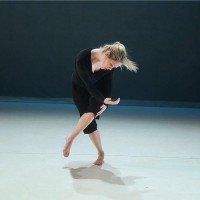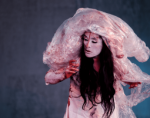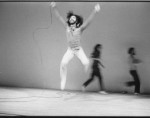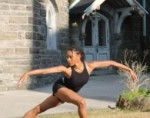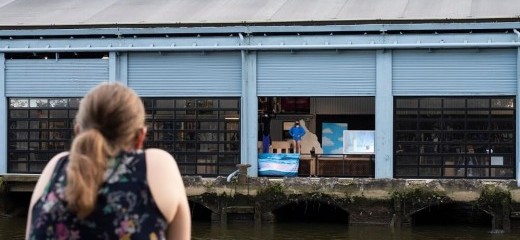
Shifting Images in an Impermanent Space
by Leslie Bush
Testing Grounds, a series of temporary installations and small public performances, has taken over Cherry Street Pier on the Delaware River waterfront. The exhibition was originally scheduled for March 2020 but recontextualized in the wake of COVID-19 and the George Floyd protests. It reimagines public spaces as intentional and malleable, reflecting how “we share space with those we do not know,” according to the curatorial statement.
The entire project involved 20 artists and collectives and included three scheduled performances. Other “happenings” were not advertised to avoid large audiences and were encountered through “a matter of chance,” according to the presenters. I visited the site throughout the month—each time the space revealed itself in new ways, like a perpetual work in process.
Above
On an elevated catwalk above the main hallway of the pier, unlit tea candles dot the ground. Audience members for (Re)Memory, choreographed by Surya Swilley, are told to stand by a candle, but most line up against the wall. Swilley, shrouded in a white lace sheet, emerges from around a corner like an apparition. She carries two lanterns; their glowing light traces her pathway through the space.
From below, I hear a poem by Amanda L. Edwards playing on a speaker. Her words, “I am bodies past and present,” solemnly echo off the high ceilings. At one point, a loud group of visitors distracts me, but Edwards’ larger than life voice calmly repeats “shhhhh, shhhhh” and the group quiets down. Swilley’s movements carry the same meditative rhythm. She glides effortlessly around the candles, and I wonder how the performance would have changed with people more evenly dispersed. Eventually she reveals her whole form from under the sheet. She drops to the ground, drifting between stillness and sweeping, gentle movement. She leaves the space unceremoniously, ghost-like.
Across
I arrive at the adjacent Race Street Pier and look out across the narrow channel of water that separates me from Julia Gladstone and Emmanuela Soria Ruiz’s performance, Floating Match on Card. They seem far away, standing in a large opening of the wall of Cherry Street Pier, facing out towards the water. But I adjust quickly to the distance because much of the beginning movement in Floating Match on Card comes from the ever-changing shift of oversized scenic pieces, furniture, and props manipulated continuously, almost imperceptibly at times by a performer—it’s hard to say who from this distance—dressed in stage-hand black. She lowers a red beach ball from the ceiling, only to take it away seconds later. She brings out fishing poles that she uses to make a pair of purple pants dance. She adjusts the angle of a painted Greek pillar. She rearranges a row of wooden chairs.
The other performer, wearing a blue sweatshirt and a fake animal tail enters the scene, taking no notice of the stage-hand or her meticulous manipulations of the set. She speaks to the audience via a microphone, which we hear through a speaker on our side of the river; the separation between the performers and us feels even more exaggerated to me. A screen with a live feed flips between still life tableaus and a view of the performers from the back. Eventually the two come together for a mesmerizing movement pattern of shifting gestures. They change their spacing and facing gradually, echoing the movement of the set, which is now almost bare. Floating Match on Card is a clever trick of the eye—the space changes in front of me, but I don’t notice until it’s already changing again.
Opposite
Performance collective YFFY’s The Chrysanthemum’s Folly begins at opposite ends of the Cherry Street Pier. The audience gathers around a huge yellow circular sculpture from which Jungmok Yi slowly crawls out, in a yellow costume covering their entire face and body. I keep my eye on the far end of the hallway though, and finally Connie Fu emerges from a small room. She is wearing bug antennae and layers of brown sheets of paper with alternating happy and sad faces covering her own face. She pulls a red wagon with vegetables behind her. Her performance is mischievous—she sneaks around the space tossing carrots and onions at people.
Most of The Chrysanthemum’s Folly involves audience participation, something I am not prepared for, and the directions we are given are not clear. I watch as people go on a scavenger hunt for flowers, and then the two characters give out fortunes to those willing to take part in the show. The stand-out moments for me come when the two characters interact, chasing each other around and playing tricks on one another. Their playful antagonism elicits a collective laugh. Occasionally, audience members pause to look at other installations—curiosity constantly reconfigures the course of the performance.
Testing Grounds, Cherry Street Pier, Oct.9-Nov. 8.
By Leslie Bush
November 2, 2020

